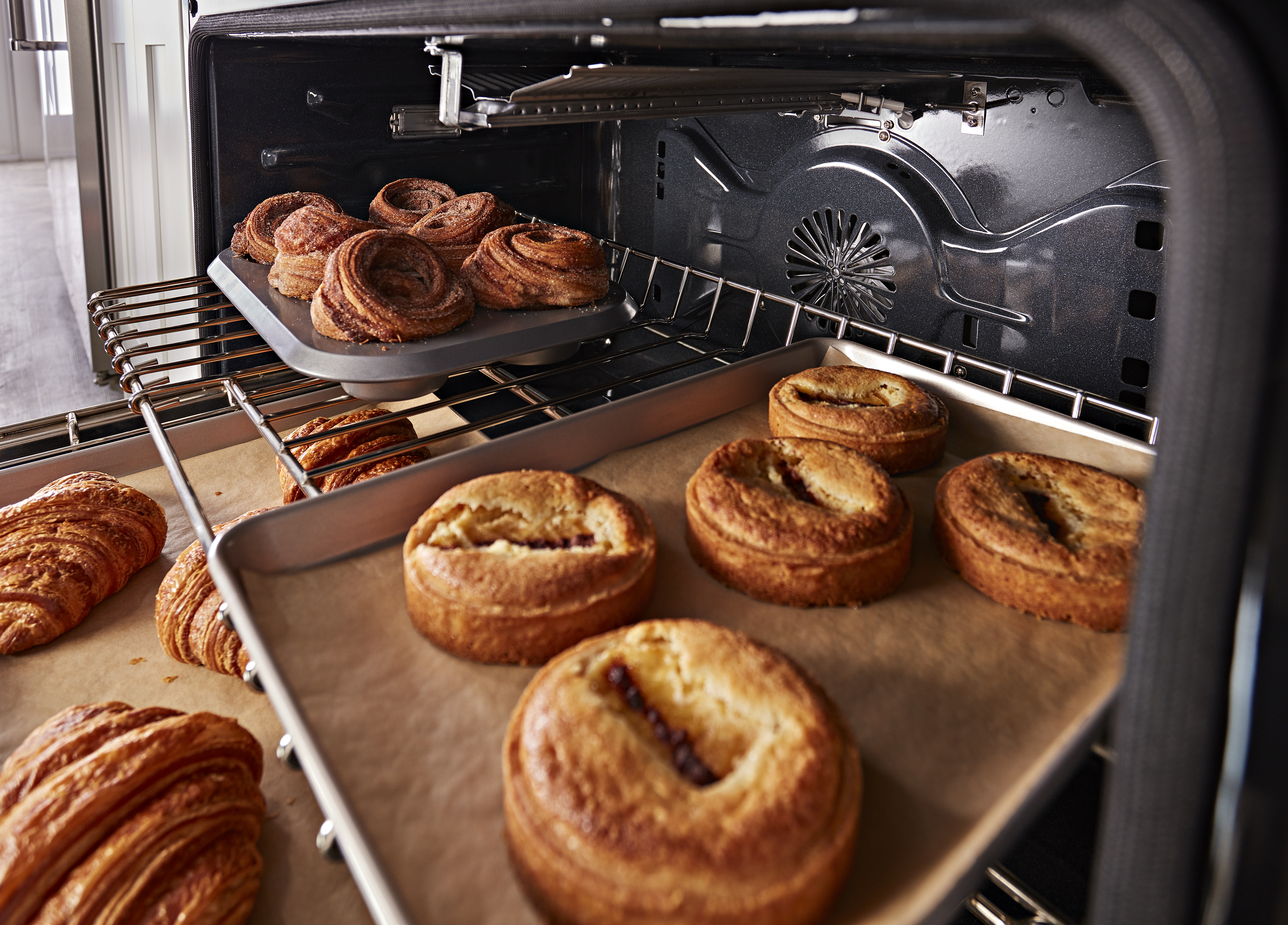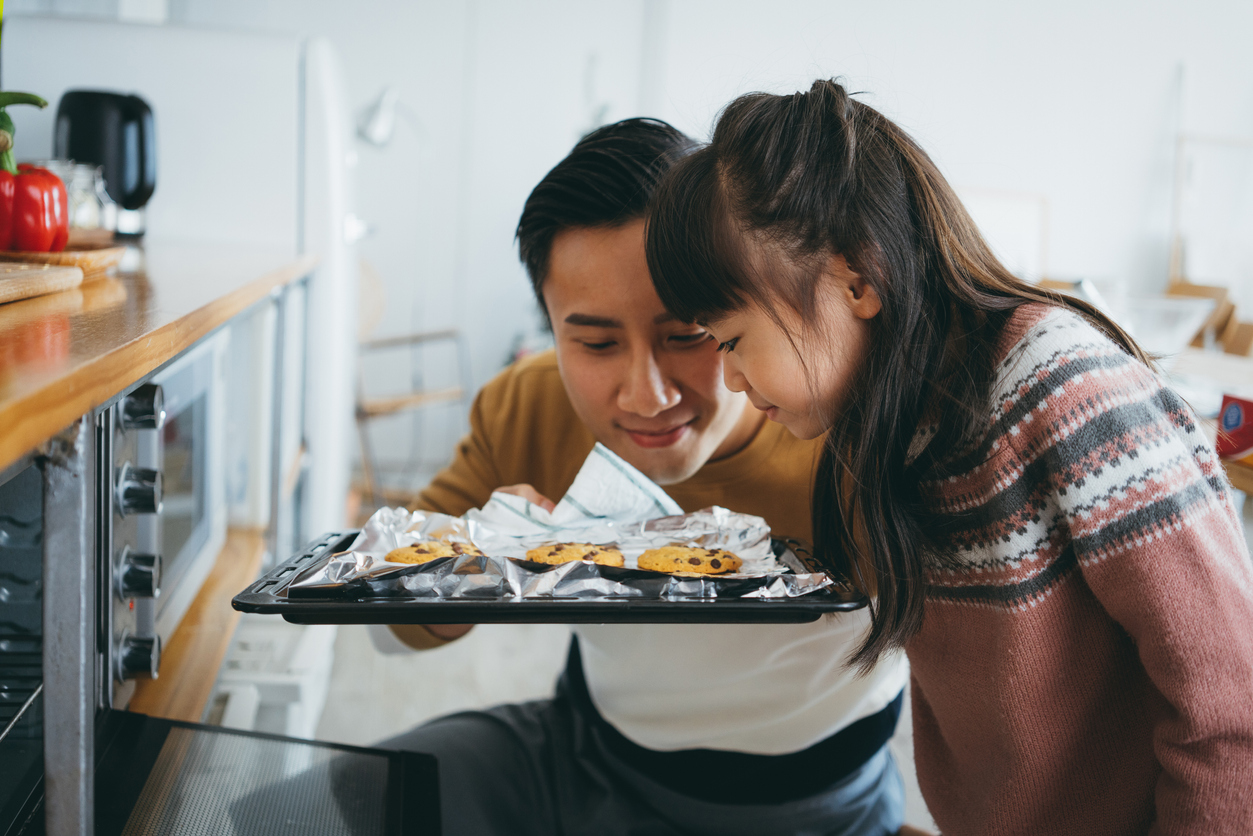Lately, it seems the hottest oven feature is Air Fry technology. Users are crazy how the hot oven settings can create crispy, crunchy grub favorites, all while using less oil and fat. We get it — it’s a bit revolutionary.
Except, this blog isn’t about air frying. This is a blog dedicated to the original oven-cooking game-changer: convection cooking. While convection ovens have been around for a while, we’re always surprised to know how many home cooks are unaware what the convection setting is.
So, if you’ve wondered what the convection setting is or how to use your oven’s convection function, we invite you to give the Air Fry button a break for the evening. Instead, try these convection cooking recipes for a tasty reminder of how incredibly useful the setting actually is.

So…What is Convection Cooking?
Ordinary ovens use radiant heat, which slowly fills the inside of the oven to a pre-set temperature. Still, despite being a relatively small space, ovens are notorious for having hot and cold spots, and depending on where a rack is placed, your oven might not be cooking evenly.
For instance, items placed on the lower rack in a non-convection oven are exposed to more heat than items placed on the upper rack. This is why recipes often call for rotating a pan or dish halfway through the cooking process. In other words, non-convection ovens require users to manually position food.
To solve this dilemma, convection ovens use a fan to evenly circulate heat throughout the oven. By doing so, the inside of the oven is consistently the same temperature, whether it’s the bottom, top, back, or front of the oven.
Are convection and true convection the same?
Also called European convection ovens, true convection ovens are simply convection ovens with an additional third heating element located at the back oven wall. While ordinary ovens have two heating elements (one on top for broiling and another on the bottom for baking), true convection ovens use a third heat source that also creates hot air.
This hot air is then distributed throughout the oven by a convection fan. As a result, foods cook faster and more uniform even compared to convection ovens.
Tips for cooking in a convection oven
As you might’ve imagined, the speedy cook times and even heating of a convection oven affect how foods will cook. Additionally, depending on the brand and model, the convection setting might not be the standard setting for an oven, and may require users to manually select the setting.
In general, home cooks can use these tips when converting a standard oven recipe to the convection setting:
- Adjust the cooking time to 75 percent (3/4th) of the cooking time and check foods five to 10 minutes before the end of cooking.
- Lower the cooking temperature by 25 degrees.
- Use low-profile trays to optimize hot airflow.
- Do not use the convection setting on wet batters, such as cakes or soufflés.
And without further ado, let’s feast! For these four recipes, we’ve converted the time and temperature. If you choose to make these recipes in a non-convection oven, simply apply the rules above!
Tender Cornbread
Is there anything quite like a big pot of Brunswick stew with a side of homemade cornbread? Don’t think — just whip out your favorite cast iron skillet and give this cornbread recipe from local food enthusiast Blair at The Seasoned Mom a try for tasty reminder.
RECIPE
- PREP TIME:10 MINUTES
- COOK TIME: 18 MINUTES
- TOTAL TIME: 28 MINUTES
- COURSE: SIDE
- SERVINGS: 8
Ingredients:
- 1 cup all-purpose flour
- 1 cup yellow cornmeal
- ¼ cup of white sugar
- 4 teaspoons baking powder
- 1 teaspoon salt
- 1 cup buttermilk or regular milk
- 1 egg, beaten
- ¼ cup oil, plus additional oil to prepare skillet
Instructions:
- Place a 10-inch cast iron skillet into a cold oven and pre-heat to 375 degrees with the skillet inside; select the convection setting (if necessary).
- Next, mix the flours, sugar, baking powder, and salt together in a bowl.
- Once combined, mix with milk, beaten egg, and oil.
- When the oven has come to temperature, use the oven rack to carefully bring the hot skillet toward you; pour two tablespoons of oil and generously coat using a pastry brush.
- Then, carefully pour the cornbread mixture into the skillet.
- Bake for 18 minutes, or until a toothpick inserted comes out clean and the cornbread is golden, brown, and delicious.
Roasted Vegetable Medley
Roasting vegetables intensifies their natural sugars, making them extremely tasty and satisfying, and with the all-around heat of a convection oven, every surface evenly caramelizes. Try this roasted balsamic vegetable recipe from pro food blogger Toni Dash at Boulder Locavore to spice up your side dish game.
RECIPE
- PREP TIME: 20 MINUTES
- COOK TIME: 38 MINUTES
- TOTAL TIME: 58 MINUTES
- COURSE: DINNER
- SERVINGS: 6
Ingredients:
- 6 medium-size carrots, peeled and cut vertically in half
- 1 cup of small Brussel sprouts, trimmed stems and cut vertically in half
- 2 cups butternut squash, peeled, cored, and cut into ½-inch bite-size cubes
- 2 medium beats, peeled and cut into ½-inch bite-size cubes
- 1 ½ cups red onion, cut into quarter wedges
- 2 tablespoons extra virgin olive oil
- 2 tablespoons balsamic vinegar
- 2 teaspoons Sumac powder
- 2 teaspoons kosher salt
Instructions:
- Pre-heat oven to 375 degrees; select the convection setting (if necessary).
- In an extra-large bowl, first combine olive oil, balsamic vinegar, and sumac.
- Next, carefully coat all the vegetables; keep in mind, beets can stain clothing and surfaces.
- On an aluminum-lined full sheet tray, evenly layer the vegetables; sprinkle over salt.
- Cook for 38 minutes, flipping vegetables halfway through for even caramelization.
- Once a paring knife pierces the vegetables with a little resistance (not mushy), remove from the oven and serve immediately.
The Best Baked Potatoes
You might be thinking, “A recipe? For roasted potatoes?” Trust us, this method is unlike any roasted potato you’ve tried. First, the potatoes are brined in a salt solution for a savory taste throughout. Then, they’re baked under even convection heat, resulting in a crispy exterior, and a soft and fluffy interior. You have to try!
RECIPE
- PREP TIME: VARIES
- COOK TIME: 35 MINUTES
- TOTAL TIME: VARIES
- COURSE: DINNER
- SERVINGS: 6
Ingredients:
- 6 medium russet potatoes, washed
- 1 ¼ cup kosher salt
- 2 tablespoon garlic salt
- 2 tablespoon seasoned salt of choice
- Freshly ground black pepper
Instructions:
- In a large container (we recommend a Cambro container), dissolve a cup of salt into eight cups of water. Once dissolved, add the potatoes, ensuring all the spuds are covered in the solution; brine for two to eight hours.
- Once the brining time is over, pre-heat the oven to 375 degrees; select the convection setting (if necessary).
- In the meantime, remove the potatoes, thoroughly dry, and generously coat with the remaining salt, plus the pepper and seasonings.
- When the oven is up to temperature, carefully place the potatoes directly onto the wire rack using a pair of tongs; cook for 35 minutes, or until potatoes are soft to the touch.
- Remove the potatoes and allow them to sit for five minutes before slicing and enjoying.
Crispy Oven-Roasted French Toast
Traditional French toast recipes are custardy in the middle with a crispy crust that is delicious fork after fork. For even more crusty goodness, try whipping up this recipe from the Nerds with Knives that we’ve converted for a convection oven setting.
RECIPE
- PREP TIME: 40 MINUTES
- COOK TIME: 23MINUTES
- TOTAL TIME: 1 HOUR 3 MINUTES
- COURSE: BREAKFAST
- SERVINGS: 4-6
Ingredients:
- 1 loaf of brioche or challah bread
- 1 1/3 cup milk
- 2/3 cup heavy cream
- 4 large eggs
- 1/3 cup white sugar
- ¼ teaspoon sea salt
- 1 teaspoon ground cinnamon
- Optional: 2 teaspoons of your favorite flavored liqueur
- 2 teaspoons vanilla extract
Instructions:
- Begin by slicing the bread into thick, 1½-inch slices.
- After, combine the milk, cream, eggs, sugar, salt, cinnamon, and vanilla together in a shallow dish.
- Once combined, arrange the slices in the dish and evenly pour the custard mixture over; allow the custard to penetrate for 30 minutes, flipping slices halfway through.
- While the bread soaks, pre-heat your oven to 300 degrees; select the convection setting (if necessary).
- During the pre-heat, prepare a 9 x 13 sheet pan with parchment paper or a silicon baking liner.
- After 30 minutes, use a slotted spatula to carefully transfer the bread slices to the prepared sheet pan.
- Bake for 23 to 25 minutes, flipping halfway through baking.
- Remove from the oven and serve with a sprinkling of powdered sugar and maple syrup.
Feed Your Foodie Needs
At East Coast Appliance, we’re passionate about your love for cooking. That’s why we proudly carry reliable cooking appliances that inspire you to keep exploring. From wall ovens and ranges, to cooktops and refrigerators, you can count on Virginia’s largest independent appliance retailer to make your cooking experience even more joyful. Shop online or in-store today!
